- Nanotechnology or nanotech in short is the technology that involves the manipulation of matter on atomic, molecular, and supramolecular scales, which is about 1 to 100 nanometers. One nanometer (nm) is one-billionth or (10-9) of a meter.
- It is the manipulation and use of materials and devices so tiny that nothing can be built any smaller.
- It involves a multidisciplinary approach involving fields such as applied physics, materials science, chemistry, biology, surface science, robotics, engineering, electrical engineering and biomedical engineering.
- Areas of physics such as nanoelectronics, nanomechanics, nanophotonics, and nanoionics have evolved during the last few decades to provide a basic scientific foundation of nanotechnology.
- Two main approaches are used in nanotechnology:
- In the “bottom-up” approach, materials and devices are built from molecular components that assemble themselves chemically by principles of molecular recognition.
- In the “top-down” approach, nano-objects are constructed from larger entities without atomic-level control.
- The impetus for nanotechnology comes from a renewed interest in colloidal science, coupled with a new generation of analytical tools such as the atomic force microscope (AFM), and the scanning tunneling microscope (STM).
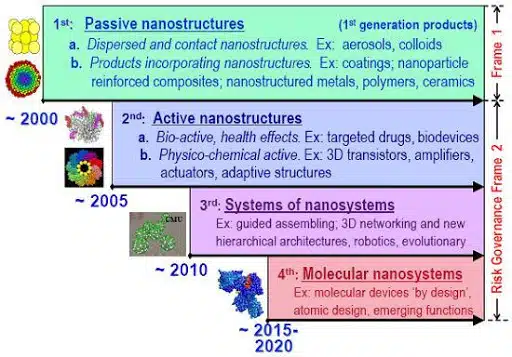
Nanotechnology Origins
- The concept behind this principle originated in a talk entitled, “There’s Plenty of Room at the Bottom” by physicist Richard Feynman in 1959. The term nanotechnology was actually coined by Professor Norio Taniguchi. In 1981, the scanning tunneling microscope was invented which made it possible to “see” individual atoms. This and the invention of the atomic force microscope (AFM) made it possible for nanotechnology to become reality. Nanotechnology has come a long way since then and now affects many industries. It is an interdisciplinary field converging many streams of engineering and science.
- Note: Size distribution, specific surface feature, and quantum size effects are the principal factors that cause the properties of nanomaterials to differ significantly from other materials.
- The nanomaterials field includes subfields which develop or study materials having unique properties arising from their nanoscale dimensions.
- Interface and colloid science have given rise to many materials that may be useful in nanotechnologies, such as carbon nanotubes and other fullerenes, and various nanoparticles and nanorods.
- Nanomaterials with fast ion transport are related also to nanoionics and nanoelectronics.
- Progress has been made in using these materials for medical applications such as Nanomedicine.
- Nanoscale materials such as nanopillars are sometimes used in solar cells that combat the cost of traditional silicon solar cells.
- Development of applications incorporating semiconductor nanoparticles to be used in the next generation of products, such as display technology, lighting, solar cells, and biological imaging.
- The recent application of nanomaterials includes a range of biomedical applications, such as tissue engineering, drug delivery, and biosensors.
Applications of Nanotechnology
Nanotechnology is a new and emerging field that has an impact on almost all sectors of the economy. The research on nanotechnology has spread across many fields like health, food, computing, textile, energy, transport, space, agriculture, etc.
Health sector:
- The application of nanotechnology in the health sector is wide-ranging.
- Nanomaterials can be used inside and outside the body.
- Thus, the integration of nanomaterials with biology has led to the development of diagnostic devices, analytical tools, drug delivery vehicles, and physical therapy applications.
- This technology has led to the possibility of delivering drugs to precise cells, ensuring greater efficiency and lesser side effects.
- Nanomaterials have also given the scope for repairing damaged tissues since the cells can be artificially produced using this technology.
- This technology has currently become an important diagnostic tool since it can sense and label specific molecules, structures, or microorganisms.
- Below are some examples of recent advances in this area:
- Cancer detection and treatment: Gold nanoparticles as probes for the detection of targeted sequences of nucleic acids, and they are also being clinically investigated as potential treatments for cancer and other diseases.
- Drug Delivery: Nanotechnology researchers are working on a number of different therapeutics where a nanoparticle can encapsulate or otherwise help to deliver medication directly to cancer cells and minimize the risk of damage to healthy tissue. This has the potential to change the way doctors treat cancer and dramatically reduce the toxic effects of chemotherapy.
- Imaging and diagnostic tools: Tools enabled by nanotechnology are paving the way for earlier diagnosis, more individualized treatment options, and better therapeutic success rates.
- Diagnosis and treatment: Nanotechnology is being studied for both the diagnosis and treatment of atherosclerosis, or the buildup of plaque in arteries. In one technique, researchers created a nanoparticle that mimics the body’s “good” cholesterol, known as HDL (high-density lipoprotein), which helps to shrink plaque.
- Genetics: The design and engineering of advanced solid-state nanopore materials could allow for the development of novel gene sequencing technologies that enable single-molecule detection at low cost and high speed with minimal sample preparation and instrumentation.
- Regenerative medicine: Research in the use of nanotechnology for regenerative medicine spans several application areas, including bone and neural tissue engineering. Novel materials can be engineered to mimic the crystal mineral structure of human bone or used as a restorative resin for dental applications. Researchers are looking for ways to grow complex tissues with the goal of one-day growing human organs for transplant. Researchers are also studying ways to use graphene nanoribbons to help repair spinal cord injuries; preliminary research shows that neurons grow well on the conductive graphene surface.
- Vaccine development: Nanomedicine researchers are looking at ways that nanotechnology can improve vaccines, including vaccine delivery without the use of needles. Researchers also are working to create a universal vaccine scaffold for the annual flu vaccine that would cover more strains and require fewer resources to develop each year.
- Smart pills: The term ‘smart pills’ refers to nano-level electronic devices that are shaped and designed like pharmaceutical pills but perform more advanced functions such as sensing, imaging, and drug delivery. Nanotechnology has previously helped in developing various kinds of smart pills, such as the PillCam, a capsule with a miniature video camera, and dose-tracking pills.
- Nanobots: Nanobots are micro-scale robots, which essentially serve as miniature surgeons. They can be inserted into the body to repair and replace intracellular structures. They can also replicate themselves to correct a deficiency in genetics or even eradicate diseases by replacing DNA molecules. This property is still under development.
- Nanofibres: Nanofibers are being used in wound dressings and surgical textiles, as well as in implants, tissue engineering, and artificial organ components. Scientists are working on developing ‘smart bandages’, which when left on the site, will absorb itself into the tissue once the wound heals. Embedded nanofibres in these smart bandages can contain clotting agents, antibiotics, and even sensors to detect signs of infection.
- COVID–19: For image-based and clinical diagnostic of COVID-19, nanomaterials are emerging as promising substrates because of their unique optical, electronic, magnetic, and mechanical properties. Nanomaterials that have been proposed for viral detection include metal, silica, and polymeric nanoparticles, quantum dots, and carbon nanotubes.
Food Industry:
- Nanotechnology provides the potential for safe and better quality food and improved texture and taste of the food.
- A contamination sensor, using a flash of light can reveal the presence of E-coli.
- Antimicrobial packaging made out of cinnamon or oregano oil or nanoparticles of zinc, calcium, etc., can kill bacteria.
- The nano-enhanced barrier can keep oxygen-sensitive food fresh.
- Nano-encapsulating can improve the solubility of vitamins, antioxidants, healthy omega, etc.
- Nano-fibres made of lobster shells or organic corn can allow for antimicrobial packaging while being biodegradable.
- Nanobarcodes are used to tag individual products and trace outbreaks.
Electronic components:
- Computers are already working on a nanoscale.
- Nanotechnology has greatly improved the capacity of electronic components by:
- Reducing the size of the integrated circuits’ transistors
- Improving the display screens of the electronic devices
- Reducing power consumption, weight, and thickness of the electronic devices.
Energy-efficient:
- This technology can improve the efficiency of the existing solar panels. It can also make the manufacturing process of solar panels cheaper and efficient.
- It can improve the efficiency of fuel production and consumption of petroleum materials.
- It is already being made use of in many batteries that are less-flammable, efficient, quicker-charging and are lightweight and higher power density.
- Broadly, it has the potential to improve the existing technologies to be more efficient with less consumption of energy.
Textile industry:
- Nanotechnology has already made revolutionary changes in the textile industry and is estimated to make a market impact worth hundreds of billions of dollars.
- Nanoscience has now produced stain and wrinkle resistant cloths and may further improve upon the existing innovations.
Environment:
- The nanotechnology has numerous eco-friendly applications.
- It has the potential to address the current problem of pollution.
- It can provide for affordable, clean drinking water through swift detection of impurities and purification of water.
- The nanotechnology can be used to remove industrial water pollutants in the groundwater through chemical reactions at a cheaper rate than the current methods that need pumping of the groundwater for treatment.
- Nanotechnology sensors and solutions also have the potential to detect, identify, filter and neutralise harmful chemical or biological agents in the air and soil.
Transport:
- Nanotechnology contributes to manufacturing lighter, smarter, efficient and greener automobiles, aircraft and ships.
- It also allows various means to improve transportation infrastructures like providing resilience and longevity of the highway and other infrastructure components.
- The nanoscale sensors and devices can also provide for cheap and effective structural monitoring of the condition and performance of the bridges, rails, tunnels, etc. They can also enhance transportation infrastructure that makes the drivers avoid collisions and congestions, maintain lane position, etc.
Space:
- Materials made of carbon nanotubes can reduce the weight of the spaceships while retaining or increasing the structural strength.
- They can also be used to make cables that are needed for the space elevator. Space elevators can significantly reduce the cost of sending materials to the orbit.
- The nanosensors can be used to monitor the chemicals in the spacecraft to look into the performance of the life support system.
Agriculture:
- The nanocapsule can enable effective penetration of herbicides, chemical fertilizers, and genes into the targeted part of the plant. This ensures a slow and constant release of the necessary substance to the plants with minimised environmental pollution.
- The nanosensors and delivery systems can allow for precision farming through the efficient use of natural resources like water, nutrients, chemicals etc.
- The nanosensors can also detect the plant viruses and soil nutrient levels.
- Nano-barcodes and nano-processing could also be used to monitor the quality of agriculture produce.
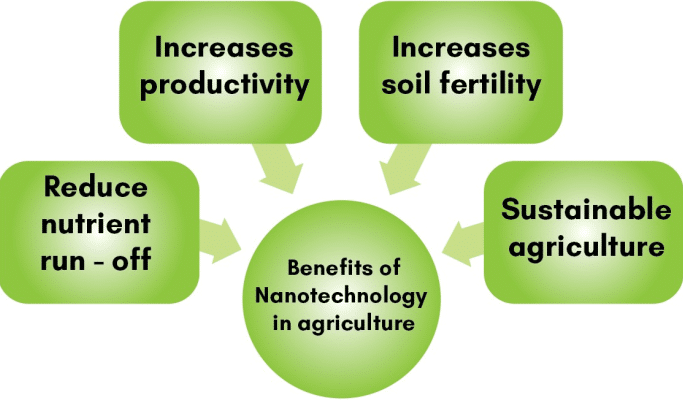
Atomic force microscopy (AFM)
- Atomic force microscopy (AFM) or scanning force microscopy (SFM) is a very-high-resolution type of scanning probe microscopy (SPM), with demonstrated resolution on the order of fractions of a nanometer, more than 1000 times better than the optical diffraction limit.
- The information is gathered by “feeling” or “touching” the surface with a mechanical probe. Piezoelectric elements that facilitate tiny but accurate and precise movements on (electronic) command enable precise scanning.
- The AFM has three major abilities: force measurement, imaging, and manipulation.
- In force measurement, AFMs can be used to measure the forces between the probe and the sample as a function of their mutual separation. This can be applied to perform force spectroscopy, to measure the mechanical properties of the sample, such as the sample’s Young’s modulus, a measure of stiffness.
- For imaging, the reaction of the probe to the forces that the sample imposes on it can be used to form an image of the three-dimensional shape (topography) of a sample surface at a high resolution. This is achieved by raster scanning the position of the sample with respect to the tip and recording the height of the probe that corresponds to a constant probe-sample interaction (see section topographic imaging in AFM for more details). The surface topography is commonly displayed as a pseudocolor plot.
- In manipulation, the forces between tip and sample can also be used to change the properties of the sample in a controlled way. Examples of this include atomic manipulation, scanning probe lithography, and local stimulation of cells.
Tissue Nano-transfection
- Tissue nanotransfection (TNT) is an electroporation-based technique capable of gene and drug cargo delivery or transfection at the nanoscale. Furthermore, TNT is a scaffold-less tissue engineering (TE) technique that can be considered cell-only or tissue inducing depending on cellular or tissue level applications. The transfection method makes use of nanochannels to deliver cargo to tissues topically.
- The new technique, called tissue nano-transfection, is based on a tiny device that sits on the surface of the skin of a living body.
- An intense, focused electric field is then applied across the device, allowing it to deliver genes to the skin cells beneath it – turning them into different types of cells.
- It offers an exciting development when it comes to repairing damaged tissue, offering the possibility of turning a patient’s own tissue into a “bioreactor” to produce cells to either repair nearby tissues, or for use at another site.
- It avoids an intermediary step where cells are turned into what are known as pluripotent stem cells, instead of turning skin cells directly into functional cells of different types. It is a single-step process in the body.
- The new approach does not rely on applying an electric field across a large area of the cell, or the use of viruses to deliver the genes.
Top-down and Bottom-up methods
- Top-down and bottom-up methods are two types of approaches used in nanofabrication.
- The bottom-up approach is more advantageous than the top-down approach because the former has a better chance of producing nanostructures with fewer defects, more homogenous chemical composition, and better short- and long-range ordering.
- A bottom-up synthesis method implies that the nanostructures are synthesized onto the substrate by stacking atoms onto each other, which gives rise to crystal planes, crystal planes further stack onto each other, resulting in the synthesis of the nanostructures. A bottom-up approach can thus be viewed as a synthesis approach where the building blocks are added onto the substrate to form the nanostructures.
- A top-down synthesis method implies that the nanostructures are synthesized by etching out crystals planes (removing crystal planes) which are already present on the substrate. A top-down approach can thus be viewed as an approach where the building blocks are removed from the substrate to form the nanostructure.
- Molecular self-assembly is the process by which molecules adopt a defined arrangement without guidance or management from an outside source. There are two types of self-assembly. These are intramolecular self-assembly and intermolecular self-assembly.
- Molecular Beam Epitaxy is an evaporation process performed in an ultra-high vacuum for the deposition of compounds of extreme regularity of layer thickness and composition from well-controlled deposition rates.
- The agglomeration of metallic nanoparticles can be performed using the well-known inert gas condensation process.
Dip Pen Nanolithography (DPN)
- Dip pen nanolithography (DPN) is a scanning probe lithography technique where an atomic force microscope (AFM) tip is used to create patterns directly on a range of substances with a variety of inks. A common example of this technique is exemplified by the use of alkane thiolates to imprint onto a gold surface.
- This technique allows surface patterning on scales of under 100 nanometers. DPN is the nanotechnology analog of the dip pen (also called the quill pen), where the tip of an atomic force microscope cantilever acts as a “pen,” which is coated with a chemical compound or mixture acting as an “ink,” and put in contact with a substrate, the “paper.”
- DPN enables direct deposition of nanoscale materials onto a substrate in a flexible manner. Recent advances have demonstrated massively parallel patterning using two-dimensional arrays of 55,000 tips.
- Applications of this technology currently range through chemistry, materials science, and the life sciences, and include such work as ultra high density biological nanoarrays, and additive photomask repair.
Nano Composite
- Nanocomposite is a multiphase solid material where one of the phases has one, two or three dimensions of less than 100 nanometers or structures having nano-scale repeat distances between the different phases that make up the material.
- The idea behind Nanocomposite is to use building blocks with dimensions in the nanometre range to design and create new materials with unprecedented flexibility and improvement in their physical properties.
- In the broadest sense, this definition can include porous media, colloids, gels, and copolymers, but is more usually taken to mean the solid combination of a bulk matrix and nano-dimensional phase(s) differing in properties due to dissimilarities in structure and chemistry. The mechanical, electrical, thermal, optical, electrochemical, catalytic properties of the nanocomposite will differ markedly from that of the component materials.
- Nanocomposites are found in nature, for example in the structure of the abalone shell and bone.
- The use of nanoparticle-rich materials long predates the understanding of the physical and chemical nature of these materials.
- In mechanical terms, nanocomposites differ from conventional composite materials due to the exceptionally high surface to volume ratio of the reinforcing phase and/or its exceptionally high aspect ratio. The reinforcing material can be made up of particles (e.g. minerals), sheets (e.g. exfoliated clay stacks), or fibers (e.g. carbon nanotubes or electrospun fibers). The area of the interface between the matrix and reinforcement phase(s) is typically an order of magnitude greater than for conventional composite materials. The matrix material properties are significantly affected in the vicinity of the reinforcement.
- This large amount of reinforcement surface area means that a relatively small amount of nanoscale reinforcement can have an observable effect on the macro scale properties of the composite. For example, adding carbon nanotubes improves the electrical and thermal conductivity.
Nano-Robots (Nanobots)
- Nanorobotics describes the technology of producing machines or robots at the nanoscale.
- ‘Nanobot’ is an informal term to refer to engineered nano machines.
- Nanobots are robots that carry out a very specific function and are ~50–100 nm wide.
- They can be used very effectively for drug delivery.
- Normally, drugs work through the entire body before they reach the disease-affected area.
- Using nanotechnology, the drug can be targeted to a precise location which would make the drug much more effective and reduce the chances of possible side effects.
Quantum Dots (QDs)
- Quantum dots (QDs) are man-made nanoscale crystals that that can transport electrons.
- Quantum dots are semiconductor particles a few nanometres in size, having optical and electronic properties that differ from larger particles due to quantum mechanics.
- When UV light hits these semiconducting nanoparticles, they can emit light of various colors.
- These artificial semiconductor nanoparticles that have found applications in composites, solar cells and fluorescent biological labels.
Nanosensors
- Nanosensors are nanoscale devices that measure physical quantities and convert these to signals that can be detected and analyzed.
- Nanosensors are chemical or mechanical sensors that can be used to detect the presence of chemical species and nanoparticles, or monitor physical parameters such as temperature, on the nanoscale
- There are several ways proposed today to make nanosensors; these include top-down lithography, bottom-up assembly, and molecular self-assembly.
- Some of the uses of nanosensors are:–
- in medical diagnostics and understanding neurophysiology;
- in pollution monitoring to detect various chemicals;–
- to monitor temperature, humidity, displacement, etc.;–
- to monitor plant signaling and metabolism to understand plant biology.
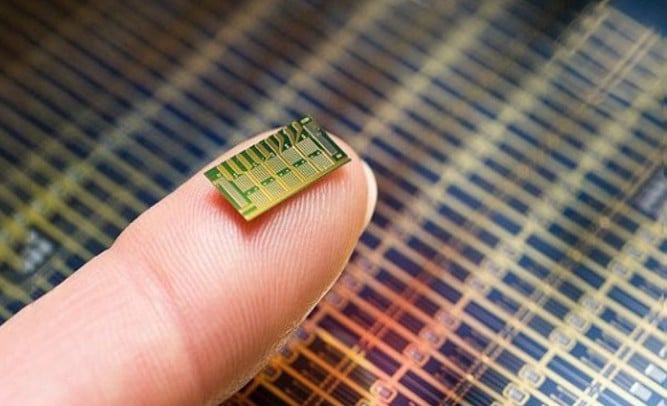
Ecophagy (Grey Goo)
- Ecophagy is a term coined by Robert Freitas that means the literal consumption of an ecosystem.
- Freitas used the term to describe a scenario involving molecular nanotechnology gone awry. In this situation (called the grey goo scenario) out-of-control self-replicating nanorobots consume entire ecosystems, resulting in global ecophagy.
- However, the word “ecophagy” is now applied more generally in reference to any event–nuclear war, the spread of monoculture, massive species extinctions–that might fundamentally alter the planet.
- The original idea assumed machines were designed to have this capability, while popularizations have assumed that machines might somehow gain this capability by accident.
- Self-replicating machines of the macroscopic variety were originally described by mathematician John von Neumann, and are sometimes referred to as von Neumann machines or clanking replicators.
Graphene
- Graphene has been touted in the global electronics industry as a “miracle material” given its strength, electrical conductivity, and elasticity, and has been seen as an alternative to lithium-ion batteries since its discovery in 2004.
- It is a form of carbon that can be used to develop smaller, slimmer batteries but with higher capacity.
- Graphene is an allotrope (form) of carbon consisting of a single layer of carbon atoms arranged in a hexagonal lattice.
- It is nearly transparent.
- It is the basic structural element of many other allotropes of carbon, such as graphite, charcoal, carbon nanotubes, and fullerenes.
- Its thin composition and high conductivity means it is used in applications ranging from miniaturized electronics to biomedical devices.
- These properties also enable thinner wire connections; providing extensive benefits for computers, solar panels, batteries, sensors, and other devices.
- The one-atom-thick sheets of carbon conduct electrons better than silicon and have been made into fast, low-power transistors. Researchers have measured the intrinsic strength of graphene, and they’ve confirmed it to be the strongest material ever tested.
- Applications:
- Graphene is widely used in making solar cells, light-emitting diodes, touch panels, and smart windows. Graphene supercapacitors serve as energy storage devices with a capacity for faster charging and a longer life span than traditional electrolytic batteries.
- Other potential applications of graphene include water filtration and purification, renewable energy, sensors, personalized healthcare, and medicine, to name a few.
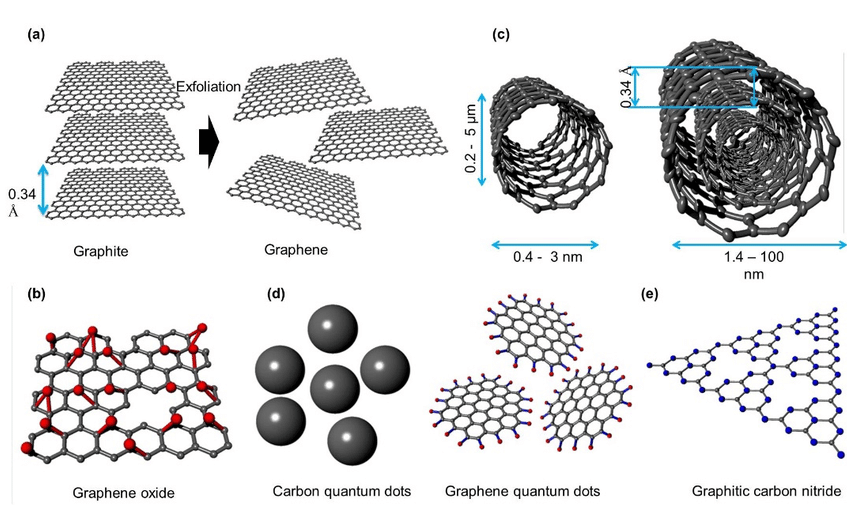
Carbon Nanotubes
Carbon nanotubes (CNTs) are an allotrope (Not isotope) of carbon.
- They take the form of cylindrical carbon molecules and have novel properties that make them potentially useful in a wide variety of applications in nanotechnology, electronics, optics, and other fields of materials science.
- They exhibit extraordinary strength and unique electrical properties and are efficient conductors of heat.
- Inorganic nanotubes have also been synthesized.
- Nanotubes are members of the fullerene structural family, which also includes buckyballs.
- Whereas buckyballs are spherical in shape, a nanotube is cylindrical, with at least one end typically capped with a hemisphere of the buckyball structure.
- Their name is derived from their size, since the diameter of a nanotube is on the order of a few nanometers (approximately 50,000 times smaller than the width of a human hair), while they can be up to several millimeters in length.
- There are two main types of nanotubes: single-walled nanotubes (SWNTs) and multiwalled nanotubes (MWNTs).
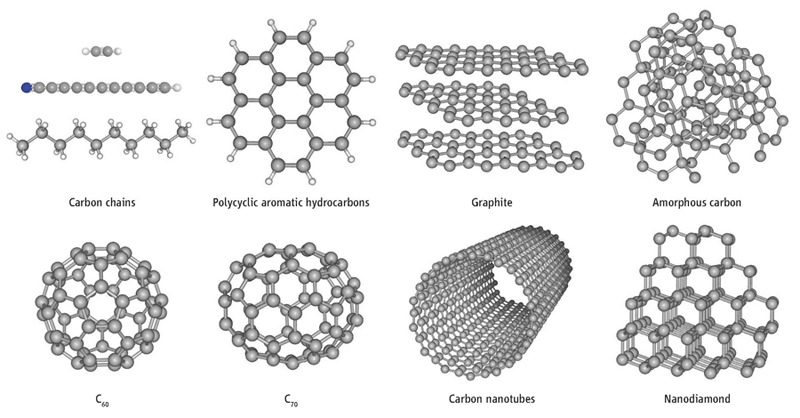
Fullerenes
Buckminsterfullerene C60, also known as the buckyball, is a representative member of the carbon structures known as fullerenes. Members of the fullerene family are a major subject of research falling under the nanotechnology umbrella.
Fullerenes are also called Buckyballs due to their shape.
- Buckyballs may be used to trap free radicals generated during an allergic reaction and block the inflammation that results from an allergic reaction.
- The antioxidant properties of buckyballs may be able to fight the deterioration of motor function due to multiple sclerosis.
- Combining buckyballs, nanotubes, and polymers to produce inexpensive solar cells that can be formed by simply painting a surface.
- Buckyballs may be used to store hydrogen, possibly as a fuel tank for fuel cell-powered cars.
- Buckyballs may be able to reduce the growth of bacteria in pipes and membranes in water systems.
- Researchers are attempting to modify buckyballs to fit the section of the HIV molecule that binds to proteins, possibly inhibiting the spread of the virus.
- Making bulletproof vests with inorganic (tungsten disulfide) buckyballs.
Reference: wikipedia.org, researchgate.net, sciencedaily.com.

perfect
Thnks
I am so thankful for this site
Really hats off to you Team Lotusarise. Reliability= Lotusarise
Thank you so much, Keep Reading